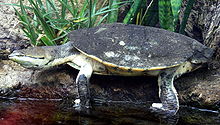Phrynops
| Phrynops | |
|---|---|

| |
| Phrynops hilarii | |
| Scientific classification | |
| Kingdom: | Animalia |
| Phylum: | Chordata |
| Class: | Reptilia |
| Order: | Testudines |
| Suborder: | Pleurodira |
| Family: | Chelidae |
| Subfamily: | Chelinae |
| Genus: | Phrynops Wagler 1830[1] |
| Synonyms[2] | |
Sometimes called the bearded toadheads but better known by their scientific name of Phrynops this genus of turtles has often been a bit of a dumping ground for the short-necked South American turtles of the family Chelidae.
The genus is widely distributed in South America found in the Orinoco to Amazon and São Francisco to Paraná and adjacent river basins of Colombia, Venezuela, the Guianas, Brazil, Paraguay, Uruguay and northeastern Argentina (Iverson, 1992).[5]
The phrynop turtle generally achieves thermoregulation through areal basking. In order to best attain their goal, they tend to increase their basking time during mid-day during the winters to make up for the cold. Other factors such as food intake and reproduction underwater also influence the way they control the temperature of their body. Although this is the main way they are able to maintain body temperature, food intake and reproduction rates are also influential in the matter.
Species[]
Listed alphabetically by specific name.[6]
- Phrynops geoffroanus (Schweigger, 1812) – Geoffroy's toadhead turtle or Geoffroy's side-necked turtle[7]
- Phrynops hilarii (A.M.C. Duméril & Bibron, 1835) – Hilaire's toadhead turtle or Hilaire's side-necked turtle[8]
- Phrynops tuberosus (W. Peters, 1870) – Cotinga River toadhead turtle[9]
- Phrynops williamsi Rhodin & Mittermeier, 1983 – William's toadhead turtle, William's South American side-necked turtle[10]
- †Phrynops paranaensis (Wieland 1923),[11] from the Huayquerian Ituzaingó Formation of the Paraná Basin, Argentina[12]
References[]
- ^ Wagler, J. 1830. Natürliches System der Amphibien, mit vorangehender Classification der Säugthiere und Vögel. Ein Beitrag zur vergleichenden Zoologie. Munich, Stuttgart, and Tübingen: J.G. Cotta. vi + 354 pp. + 9 plates. (in German and Latin).
- ^ Turtle Taxonomy Working Group [van Dijk, P.P., Iverson, J.B., Rhodin, A.G.J., Shaffer, H.B., and Bour, R.]. 2014. Turtles of the World, 7th edition: annotated checklist of taxonomy, synonymy, distribution with maps, and conservation status. In: Rhodin, A.G.J., Pritchard, P.C.H., van Dijk, P.P., Saumure, R.A., Buhlmann, K.A., Iverson, J.B., and Mittermeier, R.A. (Eds.). Conservation Biology of Freshwater Turtles and Tortoises: A Compilation Project of the IUCN/SSC Tortoise and Freshwater Turtle Specialist Group. Chelonian Research Monographs 5(7):000.329–479, doi:10.3854/ crm.5.000.checklist.v7.2014.
- ^ Gray, J.E. 1872. On Spatulemys Lasalæ, a new genus of Hydraspidæ from Rio Parana, Corrientes. Annals and Magazine of Natural History, Fourth Series 10: 463.
- ^ Wieland, George R. 1923. A new Paraná pleurodiran. American Journal of Science, Series 5, 5: 1–14.
- ^ lverson, J.B. 1992. Revised Checklist with Distribution Maps of the Turtles of the World. Richmond, Indiana: Privately Printed. 363 pp.
- ^ Phrynops, The Reptile Database
- ^ Schweigger, Augustus F. 1812. "Prodromus monographiae Cheloniorum ". Königsberger Archiv für Naturwissenschaft und Mathematik 1:271–368, 406–462.
- ^ Duméril, André Marie Constant, and Bibron, Gabriel. 1835. Erpétologie Générale ou Histoire Naturelle Complète des Reptiles. Tome Second. Paris: Roret. 680 pp.
- ^ Peters, Wilhem Carl Hartwig. 1870. "Über Platemys tuberosa, eine neue Art von Schildkröte aus British-Guiana ". Monatsber. königl. Akad. Wiss. Berlin. 1870 (Mai): 311-313.
- ^ Rhodin, Anders G.J., and Mittermeier, Russell A. 1983. Description of Phrynops williamsi, a new species of chelid turtle of the South American P. geoffroanus complex. pp. 58-73. In: Rhodin, A.G.J., and Miyata, K. (Editors). 1983. Advances in Herpetology and Evolutionary Biology. Essays in Honor of Ernest E. Williams. Cambridge, Massachusetts: Museum of Comparative Zoology.
- ^ Wieland, George R. 1923. A new Parana pleurodiran. American Journal of Science (5) v: 1-14.
- ^ Phrynops at Fossilworks.org
- Phrynops
- Turtle genera
- Turtles of South America
- Reptiles described in 1830
- Taxa named by Johann Georg Wagler